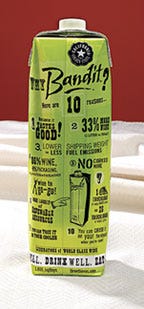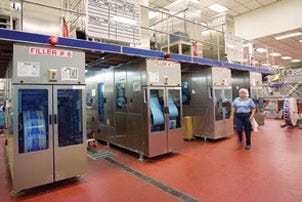Science shapes cartons
January 30, 2014
Those guys at Three Thieves (www.threethieves.com) winery have stolen another idea. Winery partners Joel Gott, Charles Bieler and Roger Scommegna claim to be “liberators of fine wines.” They were among the first in the U.S. to sell their wines in aseptic containers, and their venture appears to be wildly successful.

Three Thieves Winery has seen sales increase since they began marketing wine in cartons. On the back, winery owners list 10 reasons to drink their product.
Scommegna explains that they launched their business when there was a glut of juice and wine available in California and other wine-growing regions earlier this decade. The “thieves” would buy this surplus product, blend it into drinkable wines, package it in jugs and sell it at reasonable prices. After a visit to relatives in Italy, where he saw them drinking their everyday wines out of boxes, Scommegna suggested that the company begin packaging their wines in Tetra Pak (www.tetrapak.com) aseptic containers that are commonly used in other countries.
Sales of their Bandit wines began to take off once they began offering varietals such as chardonnay, cabernet, pinot grigio and merlot in 1-L Tetra Brik® or Tetra Prisma® containers, as well as 250-ml four-packs. Their packaging garnered a lot of attention, and now Three Thieves is selling close to 2 million units a year. Their wines are drawing favorable reviews for quality and value. Scommegna says the packaging helped build the perception of their product. “The packaging itself will create a sale once, but it's consumers liking the quality of the wine that will make the second sale,” he explains. Having a package that will protect the wine's flavor is an important factor there, too.
“The perception is that wine in a bottle is better,” he said. For many occasions, a bottle may be more appropriate, he added. However, Scommegna said, at his company they view wine as a beverage, and the carton gives it a design that is portable and eye-catching and which can be used on the dinner table or at the beach or a concert. He pointed out that in the U.S., about 80 percent of the wine is consumed within 24 hours of its purchase.
The Tetra Prisma design that Three Thieves has settled on offers long shelf life, bold display graphics that cover the package, pourable spouts that don't “gulp” and a plastic screw cap that can be resealed at a price in which the completed package costs less than a cork that is inserted into a bottle. Then there are sustainability benefits, such as using less packaging. Scommegna said the product by weight is about 96 percent wine and only 4 percent packaging, compared to about 75 percent wine and 25 percent packaging when displayed in a bottle. Combined with an efficient shape that allows tighter packing, this adds up to savings that can be passed on to the consumer.
Tetra Pak's packaging is composed of roughly 75 percent paper, 20 percent film and 5 percent foil, which is combined into a laminated, sterile package in which sterile food is filled within the confines of a hygienic environment. The package locks out light and air, seals in nutrients and flavor, and allows its contents to remain unrefrigerated for months. This minimal packaging, which uses less material from the start, also requires less energy to manufacture, fill, ship, and store than virtually any comparable package.
These attributes made it easy for Three Thieves to choose Tetra Pak cartons for their wines. However, when asked about the design process that builds all these qualities into a small package, Scommegna replied, “We're winemakers, not scientists.”

The design process may be a mystery to many consumer products companies. Frequently, they think of design as the art placed onto a package, making a bold statement about a brand's identity. When it comes to functionality, the CPGs know what they want, but it's frequently left up to the packaging company to create a design that works from both an aesthetic and manufacturing point of view.
“Both art and science must be applied to the package design process to produce a winning solution,” says Peter Mott, vp of packaging technology at Tetra Pak, which pioneered aseptic packaging for liquid foods. “Bringing the two roles of the designer and the engineer together is the challenge. That's why we take a cross-functional approach to packaging design and have our engineers and designers colocated as they work on new products.”
The company has developed a number of containers, from “juice boxes” with straws to liter-sized cartons that are known around the world. Not only does Tetra Pak design the packages, but they convert the basic materials and also supply processing and filling equipment. Mott says any new package design must meet consumer and brand owner requirements while balancing the need for highly productive and safe manufacturingat reasonable prices.
Helene Hartmann, Tetra Pak's director of new materials and package technology, says the company does not create a unique package design for every single customer. Rather, they create families of packages that can be adapted to their customers' uses through minor variations and the use of graphics. This work is done primarily at one of two Tetra Pak design labs in Lund, Sweden or Modena, Italy.
“We don't involve the consumer products companies in the early part of packaging development until we've done our homework,” she said. Hartmann added that it can take several years to develop and test an entirely new type of packaging, such as the Tetra Prisma container, which Three Thieves is using for its wines. Tetra Prisma is a carton with an eye-catching shape and excellent pouring and gripping features. It offers a resealable screw cap opening and utilizes new packaging materials. However, once a package like the Tetra Prisma is proven, it may take as little as three to five weeks for a consumer products company to speed their products to market from choice of packaging to filling of product.
“It all begins with knowledge of consumer preferences,” Mott says. “Tetra Pak has tools for understanding what consumers want.” He said they conduct workshops with customer to learn trends, and this extensive research has allowed them to segment consumers into seven groups with common attributes so they can test how packages will meet the needs of each group. “Using this segmentation allows us to put personality behind consumers, but also to recognize commonalities,” Mott says.
The company does continuous observational research, such as watching how people store and use containers. “We've even placed cameras inside the package to see how people drink from containers and to measure the differences between drinking and pouring.” In fact, pouring is an essential element of the design. With its focus on aseptic technology, Tetra Pak must remove any contamination before the package is filled. This is accomplished by passing the packaging material through a bath of heated hydrogen peroxide or acidified water for 6 sec. to to kill any potential organism that could affect food safety, then eliminating the hydrogen peroxide by using either pressure rollers or hot air. So, not only must the consumer be able to pour the product easily, but the packer must be able to ensure that the sterilization agent pours into and onto all surfaces in every corner of the carton's interior.
Mott says that while Tetra Pak is always seeking a new look, any new package must be affordable and cost-effective. A new type of package should have three attributes, he said, including a design that delights consumers, a carton that can be filled and formed with high productivity and one which uses materials that can be produced in aseptic form in Tetra Pak's converting facilities. Creating integrity for the sealed product is a major technical challenge, he said, placing a high demand the barrier qualities of the laminated structure.
Choosing the right closure, which is added after the package is filled and sealed, also can require considerable research. “For instance, the torque needed must be just right so children or older adults can open it with ease,” he says.
Mott points out that Tetra Pak then must translate the consumer research into language that the packaging engineers can use to design engineering specifications. First, they develop a 3D model. Then Tetra Pak produces a prototype that utilizes the actual materials that would be used in a production run. “The high level of science we apply to a design allows us to produce a prototype so that we can understand the touch and feel of the container,” he said.

An employee of California Natural Products monitors the Tetra Pak A/3 Flex processing system used to fill Three Thieves wines into Tetra Prisma containers.
Because Tetra Pak also produces the processing and filling machines used to fill any of its containers, they must engineer machines that will handle a new package. Most of these lines are dedicated to a single packaging or product type. Tetra Pak also must be able to print using either flexo or rotogravure press and laminate the package under controlled conditions. “We always design for high speed to help control costs,” Mott expalins. “However, it's easy to control any single attribute if you don't think of anything else. We must always balance esthetic design with the needs of the manufacturing process.”
“The advantage of working with a company like Tetra Pak is that it's a one-stop shop,” says Marc Weinstein, chief operating officer of California Natural Products (www.cnp.com). His company, based in Lathrop, CA, is a contract manufacturer of food ingredients and a copacker that uses Tetra Pak containers, processors and filling equipment. CNP fills the cartons for Three Thieves wines. “Because the operation of the machine is so integrated between the equipment, the paper, the packaging materials and all the supporting processes, if you have an issue, you've got to troubleshoot them altogether. You can't just do it in isolation. It would be miserable to try to work through several different vendors,” Weinstein says.
Only after the package has passed all these hurdles, can it be passed to the graphic designer to conceive graphics that will draw attention on the shelf.
“Three Thieves is clearly a progressive company, as you can see from their packaging, their product and their whole business model,” says Weinstein. “The design of this package fits so well. It's easy to open. It doesn't need any tools. It has the sustainability message. It fits with what they are trying to do, giving people a great product at a low price.”
Perhaps that's why use of this packaging design is growing so rapidly among U.S. winemakers such as French Rabbit, Green Path and Vendange, as well as a host of wineries in other countries. It just might be an idea worth stealing.
More information is available: |
|---|
Tetra Pak USA, 847/955-6000. www.tetrapak.com |
California Natural Products, 209/858-2525. www.cnp.com. |
About the Author(s)
You May Also Like


